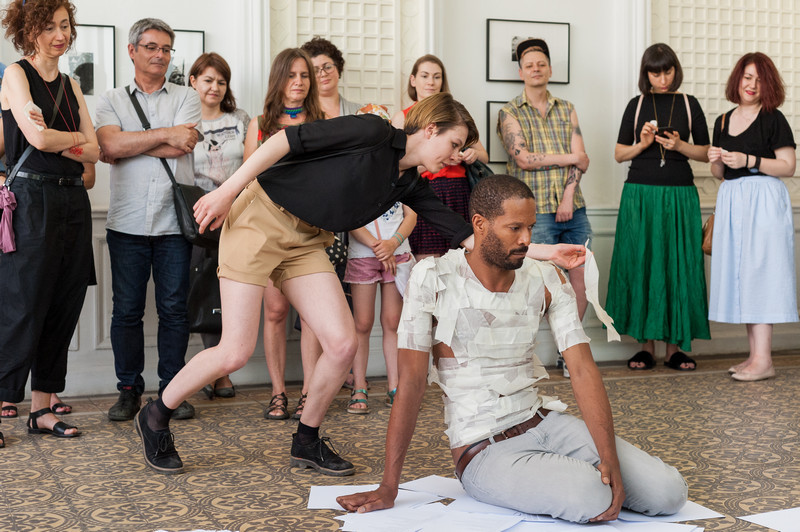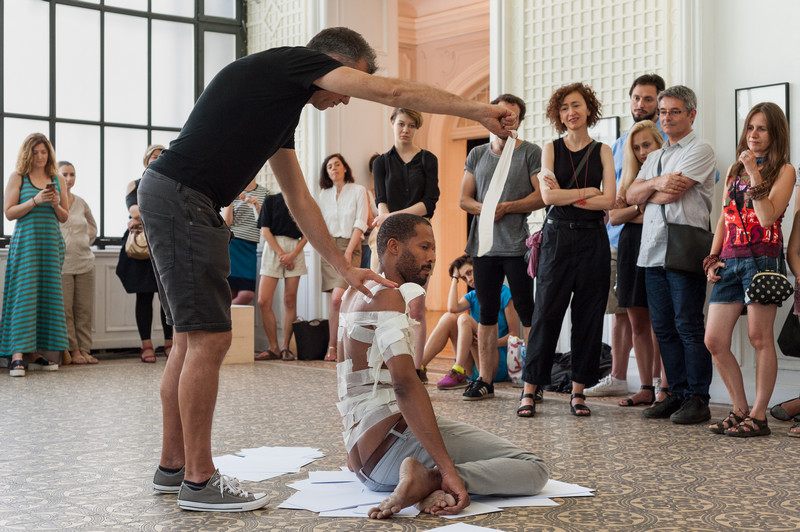Potemkin Palace | Exhibition views
Palais Potemkine | Vues d'exposition
Photos: © Kalin Serapionov (exhibition views), Emile Ouroumov (performances)
Texts: © Ina Belcheva
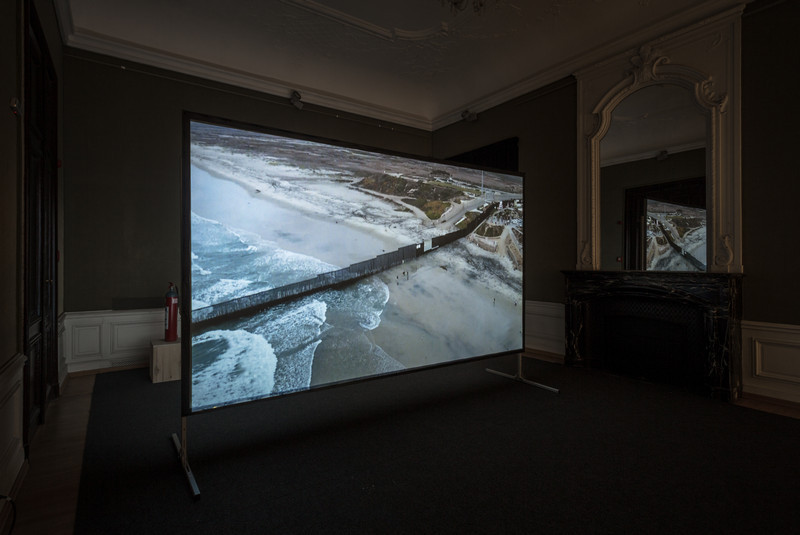
As the Coyote Flies, 2014
Via photography, video, sculpture, and installation, Adrien Missika works
on the themes of travel and exotics, the unknown and timelessness. The
work entitled As the Coyote Flies (2014) takes up the role of a symbolic
threshold to the exhibition. Adrien Missika has shot in video 11 attempted
flyovers, from various geographical points, of a drone over the USA-Mexico
border wall, focusing not only on the section already constructed, but also
on the landscape contrasts on both sides of the wall. The artist compares
the done he shot in flight to a “coyote” – slang term for Mexican traffickers
of illegal migrants through the border.
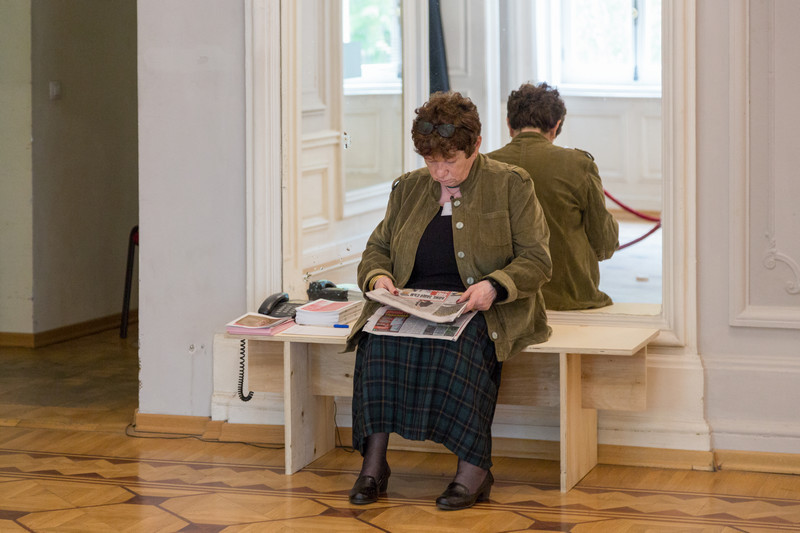
National Gallery, 2017 (specific production)
Stéphane Barbier Bouvet’s work and the objects he creates are a replica of
certain environments and situations, a search for forms and dependencies
among them.
National Gallery, 2017 (Specific production)
The installation closely connects to the exhibition space, that is to say the
former palace, and the various pieces of furniture and objects, as well as
the security personnel in the halls, whose continual presence lends a sense
of permanence, to the point they become unseen and invisible in a gallery.
Playing on the various rules and conditionalities, the work is a self-styled
dialogue between the objects and persons’ original purpose or role, and
their aesthetization. Pianos, armchairs, fire extinguishers form part of the
objects, which, being grouped by dimension and proportion, tell of the legacy
from various eras in the furnishing of the halls.

We Didn‘t Cross the Border, the Border Crossed Us, 2014
Stéphane Barbier Bouvet
National Gallery, 2017 (specific production)
We Didn‘t Cross the Border, the Border Crossed Us (2014)
is a series of black & white photos of the saguaro cactus, which is
typical for the USA-Mexico border area. Situated outside of any other
context, these plants, being typical of Arizona and Northern Mexico and
having an exceptionally long lifespan occasionally reaching 150 years,
are presented as portraits. With this series Adrien Missika reminds of
the constantly changing borders and their artificial nature.


Slapdash, 2017 (specific production)
Julien Bismuth’s work connects to literature and visual arts. For
years, he has been working on language codes, in their textual
as well as physical dimensions. His performances, the theatric
dialogues between objects, music, and gesture, often have a
storytelling element. Slapdash, 2017 (Specific production) With
minimal and simplified gestures the artist takes out of his coat’s
pockets various objects, such as rubber gloves, flour, a hammer,
scissors, a photo… following a scenario written on the museum’s
mirrors. Taken out of context, the gestures and objects appear
accidental but they gradually acquire meaning and turn out to be
connected to the Palace space.

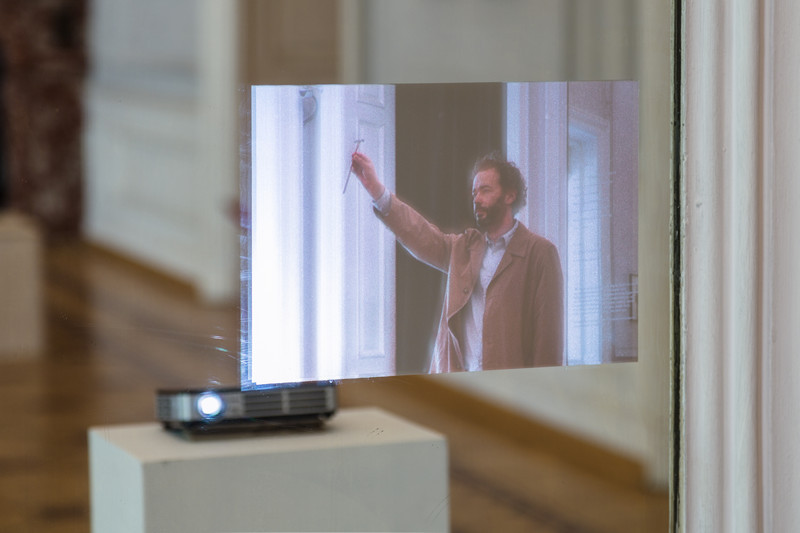
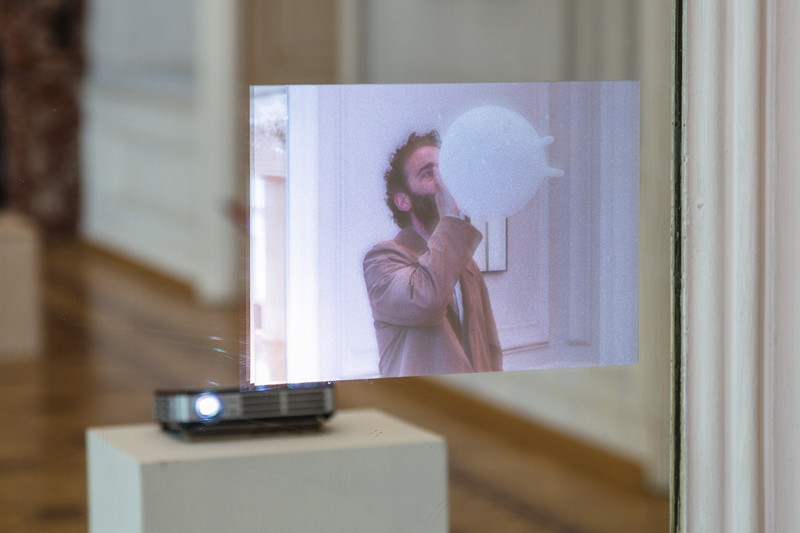
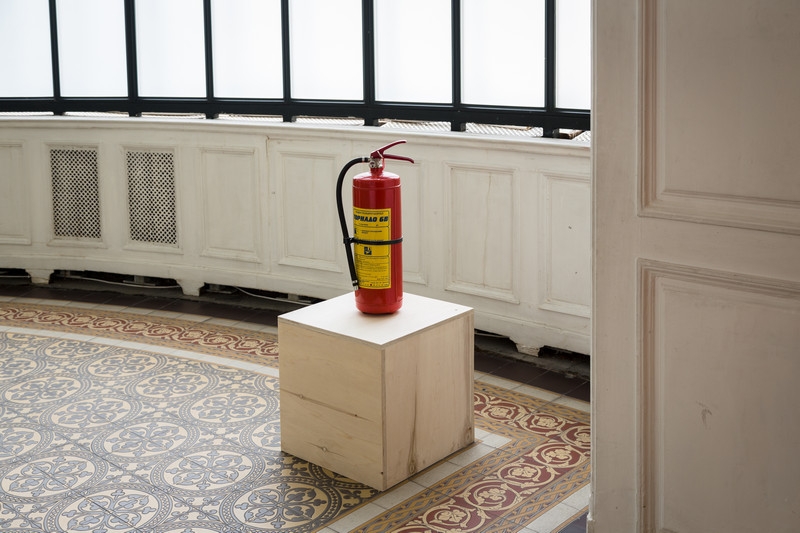
National Gallery, 2017 (specific production)
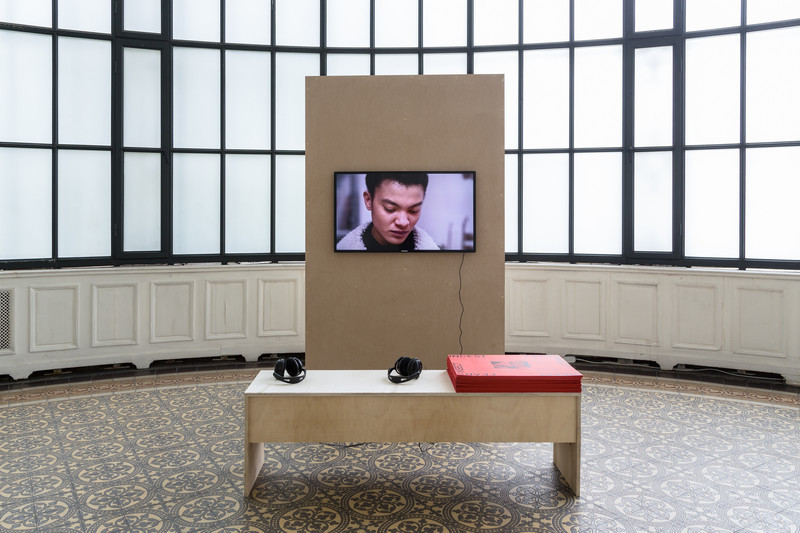
Secteur IX B, 2015
The Fear of Insects, The Fear of Incest, 2014
Mathieu K. Abonnenc’s work focuses on the issue of cultural
domination whereon contemporary societies are based. Through
video, photography, painting, installation, curatorial projects, he
explores the principles of dominant presence associated with the
imperial and colonial history of so-called “developed” countries.
Secteur IX B, 2015
Inspired by L‘Afrique fantôme – the scandalous diary of the French
surrealist Michel Leiris about his involvement in the ambitious
ethnographic Dakar-Djibouti expedition in the 1930s, Mathieu
Kleyebe Abonnenc presents in his first feature film his reflexion on
identity, cultural subjugation, objects as bearers of memory, as well
as the role of museum institutions in these processes.
Betty (Betty Chomanga) is a young anthropologist working on
the Dakar-Djibouti mission. Her research takes her from the
IFAN Museum of African Arts in Dakar to the Museum of Man
in Paris. Seeking the borders of anthropology, she decides to
use medicines from the 1930s expedition aid kit. In psychedelic
delirium, Betty holds fast to a recently discovered family archive.
The Fear of Insects, The Fear of Incest, 2014
The poster by Mathieu Kleyebe Abonnenc, which accompanies
and supplements his film, further elaborates of the issue of
subjectivity and objectivity of the researcher and the artists. The
poster reproduces drawings by Emile Abonnenc, the artist’s
grandfather, an entomology researcher. The new type of mosquito
he discovered, Phlebotomi, was named after him – Abonnenci.
The artist sees in this yet another aspect of colonization and offers
a different perspective on the issues of identity.
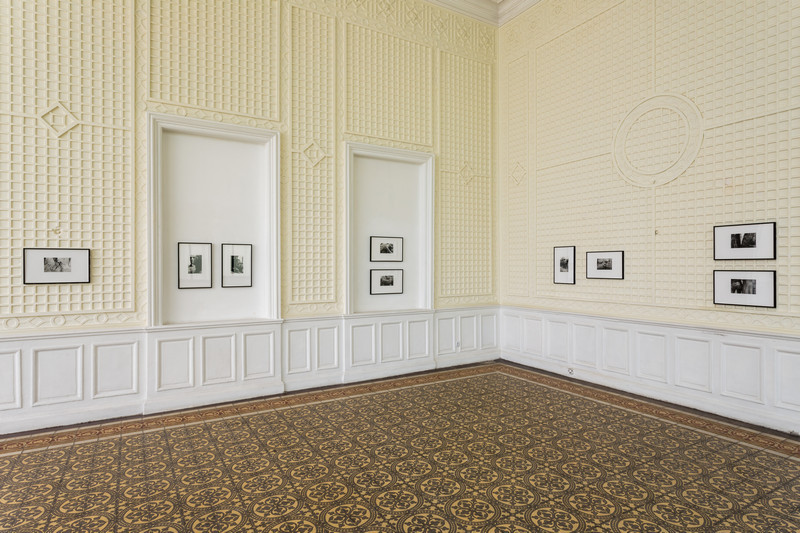
Forever Weak and Ungrateful, 2015
Forever Weak and Ungrateful (2015) is a series of
photogravures realized by Mathieu Kleyebe Abonnenc and
themed on the monument of Victor Schoelcher, one of the prime
contributors to the cause of abolitionism in France. The monument
is located in Cayenne, the administrative centre of French Guiana
and the artist’s birthplace. The sculpture by Louis-Ernest Barrias
depicts the statesman, who proudly shows the way to freedom to
a young, semi-naked slave, whose shackles lie broken at his feet.
The photogravure’s (old photographic technique, whose closeness
to gravure is reminiscent of sculpture’s 3D) enables fixation on details
clearly presenting the dominant/dominated relation between the two
characters – starting from the difference in clothing, through the
mentoring hand on the shoulder, to the freed slave’s grateful gaze.
Abonnenc’s work focuses on the complexity of the analysis of
colonialism traces in the post-colonial era’s urban environment.
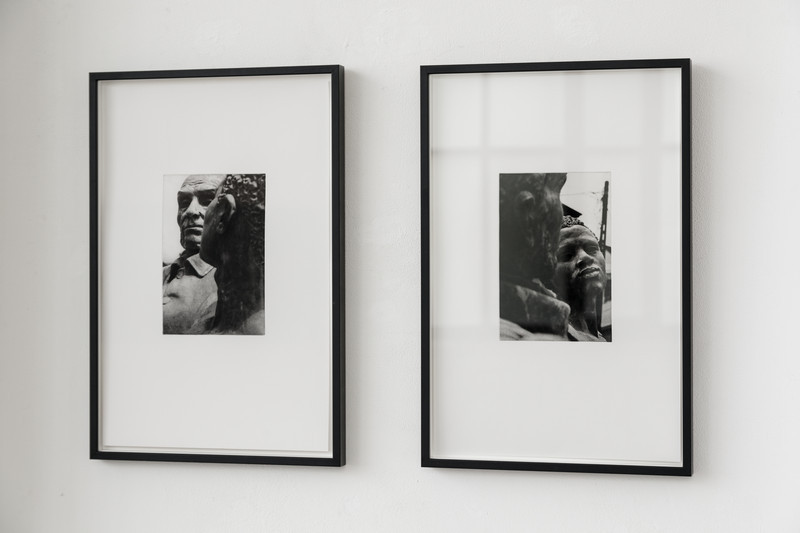

Series Calais, 2006-
Bruno Serralongue’s work focuses on the status, uses, and
circulation of the media image. His practice is close to photojournalism
and targets the “background” of politics. Serralongue’s photographs
offer a new, critical look at the current events and the media world.
Series Calais, 2006-
Opened back in 1999, the Calais camp gathered a huge mass of
refugees wishing to cross over into England. Between 2008 and
2014 the migratory stream to the city was relatively stable but
this changed after 2015 when by virtue of a decision of France’s
Interior Minister, all temporary camps were demolished and the
refugees were interned into what human rights organizations
would later call “state-owned ghetto”, while the media made it
popular as the Jungle of Calais. Crime is on the rise but police
stays out of what takes place in the camp’s interior. The number
of refugees therein exceeded 10 000 in 2016. Between 24 and 28
October the camp was dismantled and the refugees were resettled
in various centres throughout France. Bruno Serralongue shot the
camp’s evolution showing us a different and very human face of
the camp.
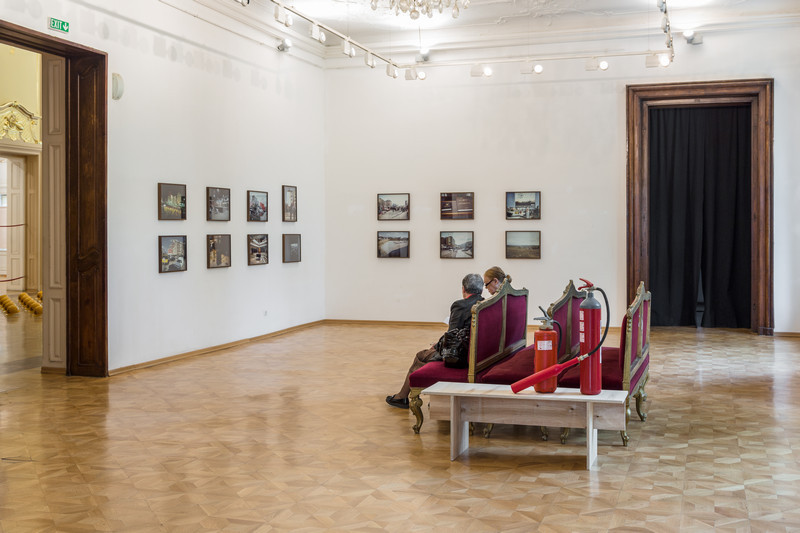
Kosovo, ensemble 1, 2009
Stéphane Barbier Bouvet
National Gallery, 2017 (specific production)
Kosovo, ensemble 1, 2009
Representing the first chapter of the Kosovo series, the displayed
photographs were shot during the first anniversary of Kosovo’s
independence, February 17, 2009. Bruno Serralongue follows the
establishment of a new state and national identity building.
Shooting individual and seemingly insignificant moments from
Kosovo’s daily life, Serralongue shows us scenes from markets,
streets, museums, boxing tournaments, making us think how the
image of a country is created.

Series Calais, 2006-
Stéphane Barbier Bouvet
National Gallery, 2017 (specific production)
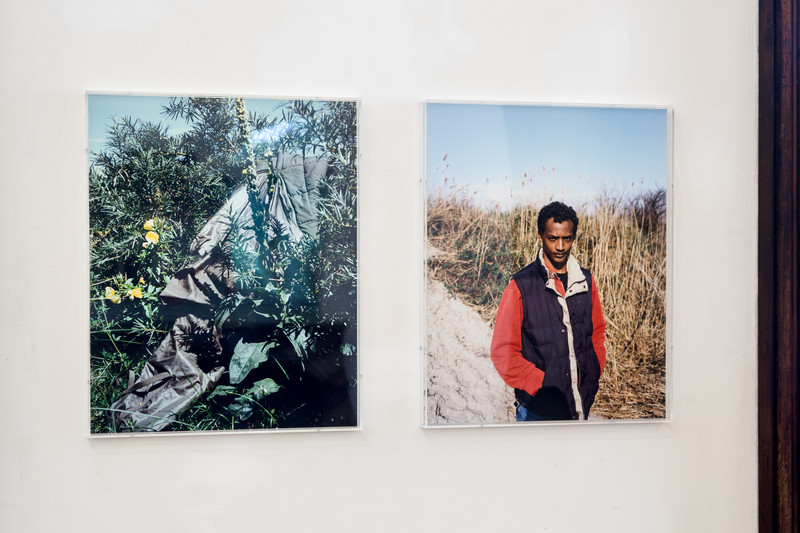
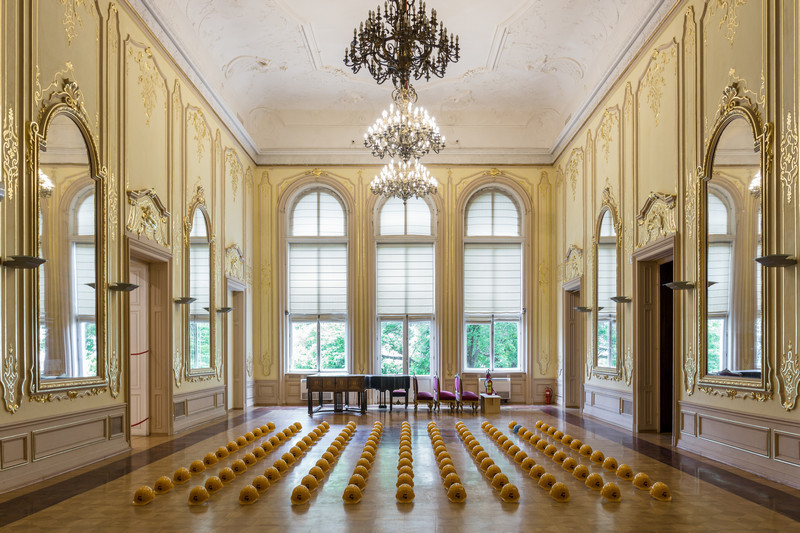
Under Deconstruction, 2002/2017 (specific production)
Stéphane Barbier Bouvet
National Gallery, 2017 (specific production)
Stefan Nikolaev’s work is based on presence and absence,
on association games, as well as on transformation and
resemanticization of objects. Under Deconstruction, 2002/2017
(Specific production) Reactivation of the work presented in
2002 at the Cetinje (Montenegro) biennale. The installation’s name
embodies a play of words (originally “under construction” with a
“de” prefix added in the new version: “under deconstruction”). The
worker helmets placed throughout the hall are a throwback to the
various helmets having crossed the Balkans over the years: Nazi,
Soviet, Blue ones…. and, in present days, the worker helmets,
which represent the quickly changing regional context and
landscape.
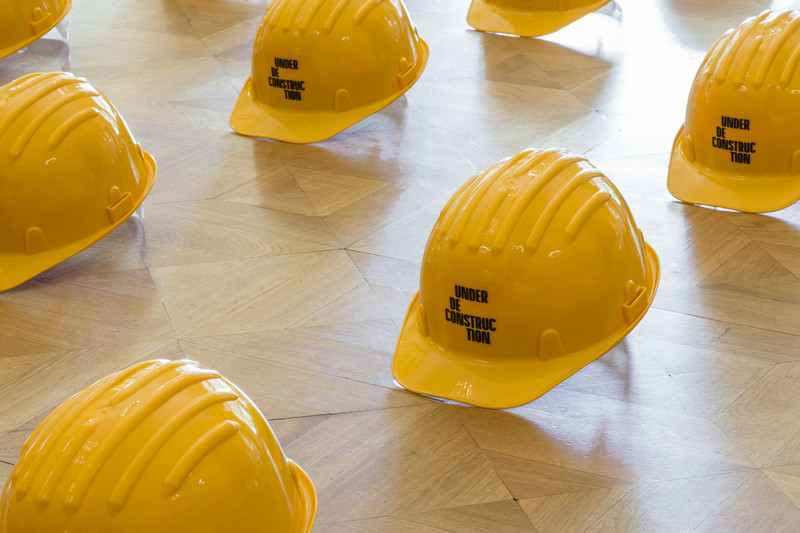
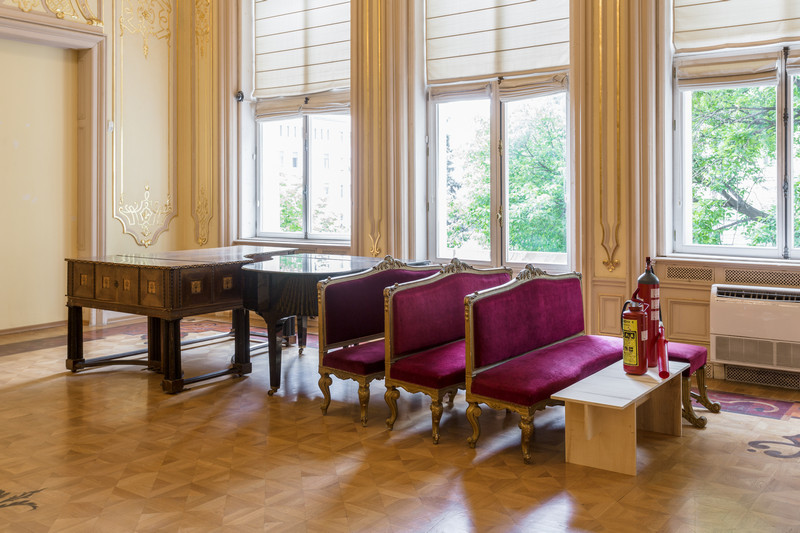

La performance des Saint-simoniens, 2015
The work of Louise Hervé & Chloé Maillet varies between
performance and film, mostly focusing on theater and narrative, on
history and historical reconstructions.
La performance des Saint-simoniens, 2015
With their slide-projection, Louise Hervé & Chloé Maillet seek the roots
of performance in history, long before the 20th century, and find them
in the communities, who fought for change of the social structure and
relations. The performance of Saint-Simonists began in 1830 when
a small utopian group retired to an estate where it set up an
artistic-political commune. Twice a week their home would open its
doors to anyone wishing to observe the daily life within. The artists
see in this a proto-form of performance, a mise-en-scene of utopian
ideas. In their “spectacle” the Saint-Simonists are not actors – they play
their genuine roles.
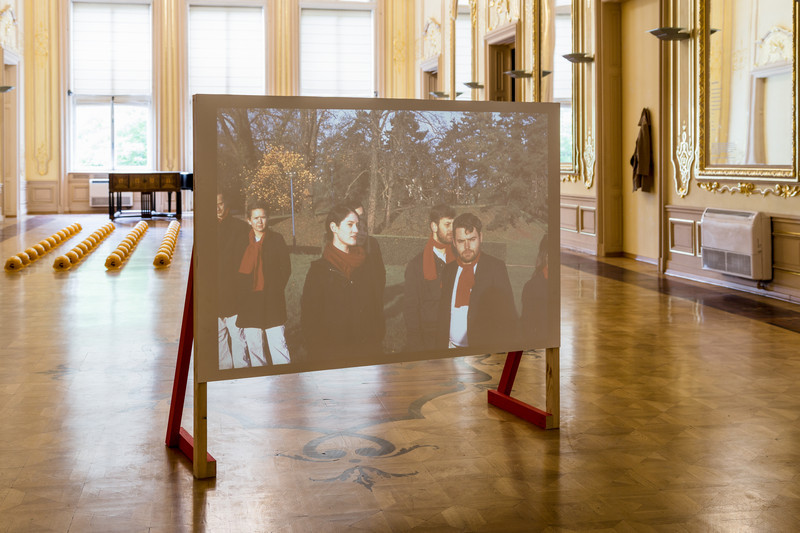
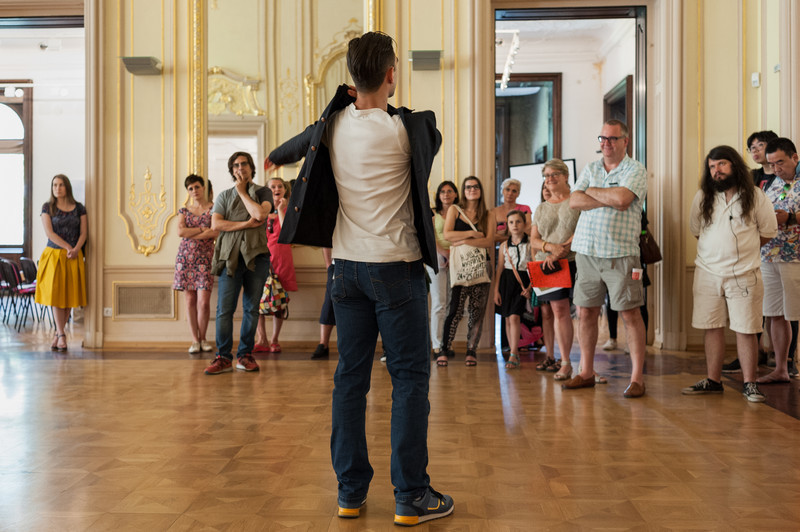
A side, 2016/17
(performed by Stefan Dodurov)
During the exhibition the performance A-side is activated
on several occasions, with the performer inviting the audience
to jointly reconstruct history but also make their own internal
reconstruction.
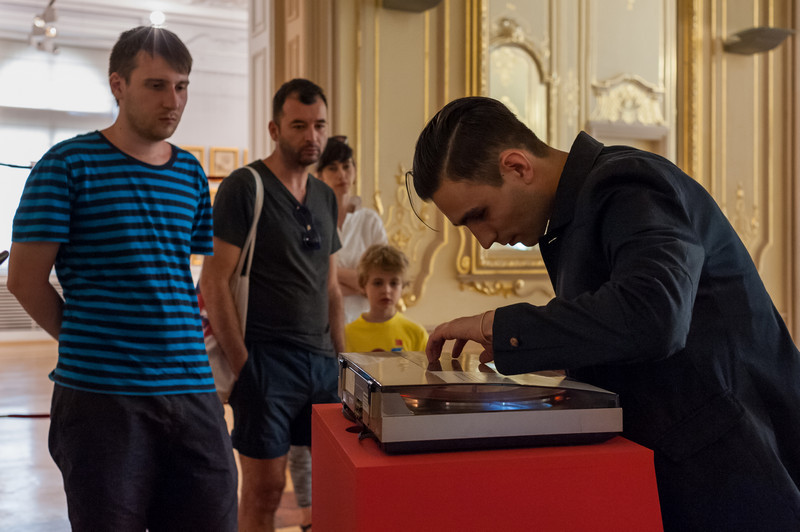

Fence (After Owen Luder), 2013
Between iconoclasm and minimalist aesthetics, between
romanticism and land art, Cyprien Gaillard’s work follows the
human footprint stamped on nature.
Fence (After Owen Luder) (2013) is a reproduction of a
semi-circular bronze fence, an architectural element of the now
demolished car park designed by the British brutalist architect
Owen Luder, which was built in the English town of Gateshead.
Despite numerous awards and titles bestowed on the architect,
his buildings are seen as unaesthetic in recent decades.
The grates installed on the car park’s building are part of the
so-called “protective architecture” – they aim to prevent thrill
seekers from climbing the building. Gaillard follows the process
of destruction of this architect’s legacy: “I wanted to make a
monument to a dead building, to Luder,” Gaillard said. “I have the
feeling that all cities will start to look alike in the drive for urbanistic
changes. To erect the building is a symbolic act: they destroy it,
I rebuild it.”
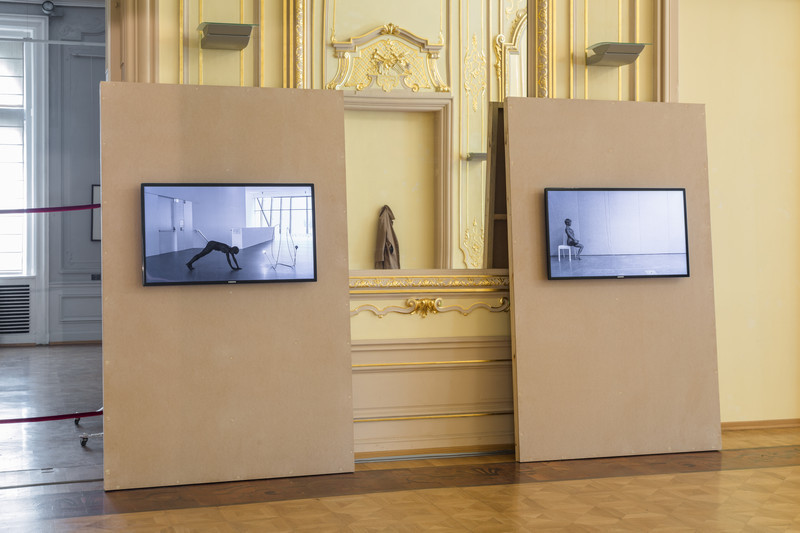
Vivre avec ça?! Museion (Soleil politique), 2014
Lili Reynaud-Dewar’s works mix cultural influences from the
Rastafari movement, through jazz, voodoo, conceptual art,
cinema, and design. These elements are mixed into video art,
sculptures, sound installations, and filmed performances.
The video entitled Vivre avec ça?! Museion (Soleil politique)
(2014) connects to poem of American poetess Eileen Myles and is
representative of the artist’s work. Reynaud-Dewar paints her boy
black and dances in the empty exhibition halls of the Bolzano’s
(Italy) Museion art center. Her movements are inspired by those
of Josephine Baker, who in the 1930’s became a symbol of racial
stereotypes but also of the struggle to overcome them. The dance
does not stop in the exhibition hall, it goes on in other –
audience-inaccessible – parts of the building – corridors, offices,
technical rooms. Thus the performance turns into an intimate criticism
of the museum institution and a deliberation on the long history of
social and cultural initiatives to overcome sexual, racial, and political
stereotypes.
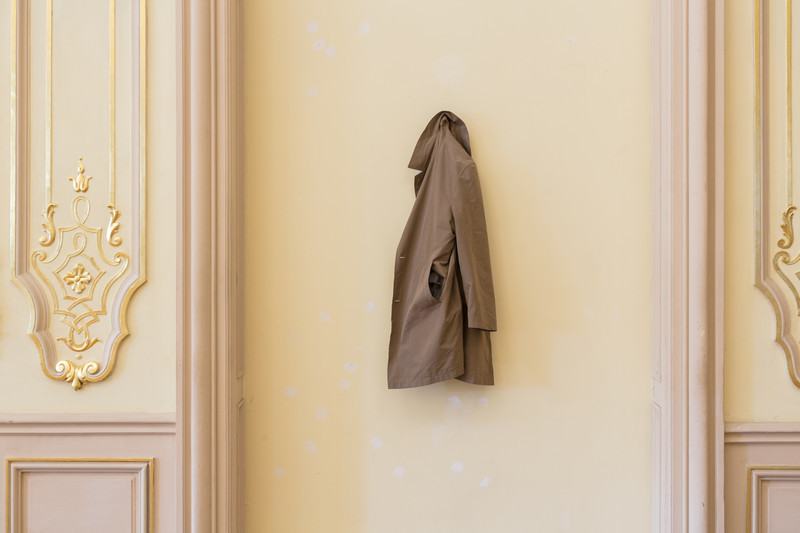
Slapdash, 2017 (specific production)
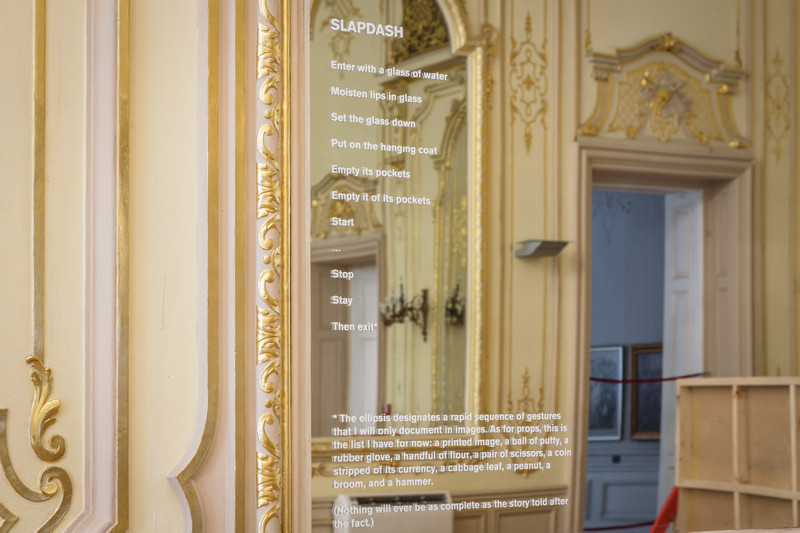


Usine à divertissement, 2016
Stéphane Barbier Bouvet
National Gallery, 2017 (specific production)
With her videos, installations, and paintings, Bertille Bak looks at
categories such as identity, society, territory, and memory, placing
man at the basis of their analysis. Her stories attempt to explain
the present of a certain social group and interrelations therein.
Usine à divertissement, 2016
Bertille Bak’s interest is drawn by the simultaneously thriving
and destructive tourism industry and its impact on local traditional
communities. The triptych follows the Lahu tribe in Northern Thailand,
peasants from Northern Morocco, and residents of Camargue
(Southern France) – all of them heavily dependent on mass tourism.
With her committed work Bertille Bak presents a spectacle in search
of exotics, local traditions perverted to extremes, and a parody of
the rivalry in the marketing of adventure and unique sensations.

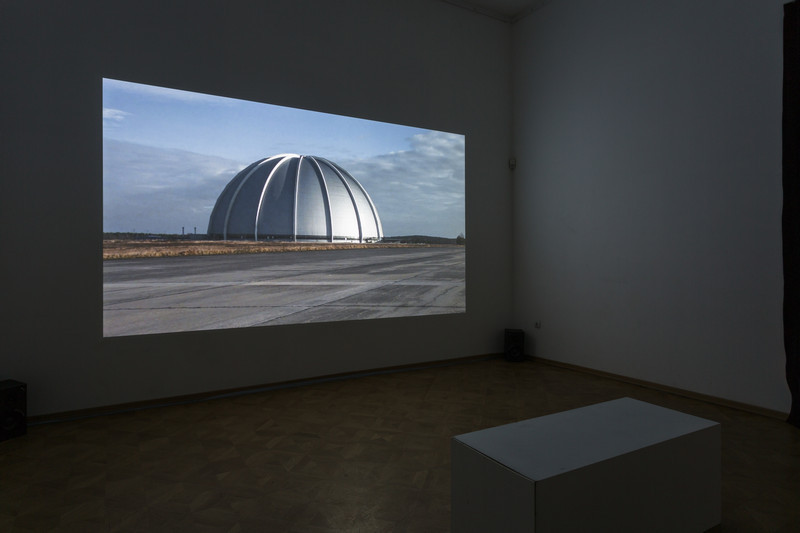
Hinterland, 2009
Marie Voignier’s work is directed to localities of no particular
attraction, from desert terrains to hangars. Through symbiosis
of the roles of documentarist and artist, she reveals specific
features of contemporary societies.
Hinterland, 2009
70 km from Berlin, at the location of a former military base,
a giant metallic cupola has been erected, beneath it are
Tropical Islands – a recreation facility imitating the perfect
vacation on a Pacific island. Marie Voignier follows the history
of this surprising place: Soviet occupation, shutting of the
GDR borders, fall of the Berlin Wall, and Soviet withdrawal,
an utopian project for construction of airships, and residential
xenophobia. Refracted through the park’s attractions,
Hinterland tells of the transformation of a society from being a
“socialist” to a “capitalist” one, of our societies’ consumerism,
of the façades, and what is hidden behind them.
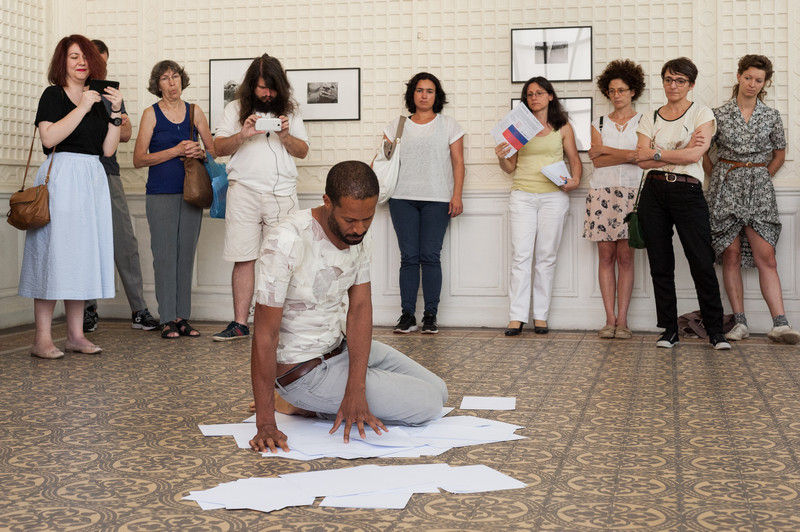
Figure de style, 2008
Following in the footsteps of female artists (the choreographer
Yvonne Rainer, performance artist Carolee Schneemann,
or Marguerite Duras, whose literary and cinema works are
strong inspirations for him), Jimmy Robert builds an artistic
genealogy, which steps out of the patriarchal pattern.
Figure de style, 2008
Figure de style is a repetition of Yoko Ono’s famous 1965
Cut Piece performance, where she asked the audience to
cut her clothes with scissors, gradually stripping her naked.
Jimmy Robert borrows the principle of original performance,
its eroticism and violence, thereby adding other issues to the
gender matters – the presence of black identity in museums.
